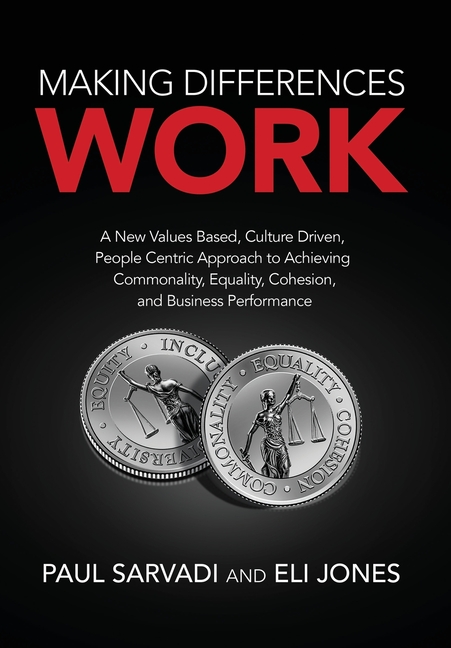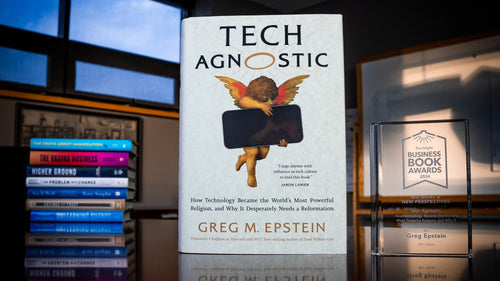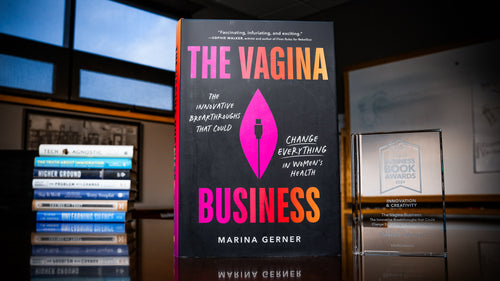An Excerpt from Making Differences Work
 Imagine a work environment where every person is appreciated. Every person. Where diversity, equity, and inclusion are more than admirable aspirations but instead clearly defined plans with proven methods of achievement. Where everyone is committed to pulling on the same rope, devoted to creating a culture with a strong sense of belonging, and unlocking new levels of business performance and success.
Imagine a work environment where every person is appreciated. Every person. Where diversity, equity, and inclusion are more than admirable aspirations but instead clearly defined plans with proven methods of achievement. Where everyone is committed to pulling on the same rope, devoted to creating a culture with a strong sense of belonging, and unlocking new levels of business performance and success.
Through Paul Sarvadi's thirty-plus years of running a multibillion-dollar company and Eli Jones' multi-award-winning career in publishing sales and strategy research, and teaching, plus scientific studies and real-world applications, the wealth of knowledge in Making Differences Work will show you how to:
- Implement a values based, culture driven, people centric approach of commonality, equality, cohesion, and belonging to achieve the original unifying goals of diversity, equity, and inclusion.
- Create a highly collaborative culture full of purpose, focused on what we have in common, not the things that divide us.
- Align core values between employer and employees for a greater ability to achieve dynamic business results by unlocking employee engagement.
- Develop discretionary effort from employees and team creativity resulting in high performance across the organization.
Two sides of a coin with one goal: deepen employees' care and concern for one another and become a shining example of the best place to work for people of all backgrounds.
The excerpt below comes from Chapter 3, which looks at where we've been, and where have need to go next.
◊◊◊◊◊
Diversity, Equity, and Inclusion, a Historical Perspective
During the Civil Rights movement, diversity education was beginning to appear in workplaces around the country. The hope was that raising the level of conversation around diversity and its various issues would eventually lead to lasting change in society as a whole. As a result of this push toward integrating diversity into the conversation, marginalized Americans were given much better, more specific language to describe their plight.
Diversity: The Right Thing to Do
So why is diversity important in the first place? Well, today, looking back, it’s easy to see that it’s the right thing to do. But if history has proven anything, it’s that rarely do things change just because “it’s the right thing to do.”
Back in those days we had quotas, which ensured an equal opportunity for people of color to join companies, join the ranks, and get involved. Quotas were needed at that time, in our perspective, to get the ball rolling, but in many cases we are still struggling in this area. For many companies, even though quotas are no longer legal under Title VII, the question remains, “Can we really get the diversity of thought we need so we can create and be more innovative as companies?” Certainly, diversity goals can be structured in a way that are not quotas and not in violation of Title VII.
Eli remembers the days when he worked for Frito-Lay; they talked about diversity quite a bit. “We asked ourselves, ‘Why is diversity important?’ By honestly answering that question, we realized that having variety enabled us to hear from other cultures, other ethnic groups. “When Quaker Oats finally put an emphasis on diversity, they took the opportunity to hire folks like myself and my good friend Dennis Maple. That strategically placed us in the conversation, providing valuable input to brand managers on well-known products. For example, we were able to enlighten them about just how offensive the Aunt Jemima product was. And in 1989, they finally changed the logo from the one with the rag on her head, which by the way, was a throwback to the slavery days when the mammies were preparing the pancakes and serving the plantation master and his/her children. That was the image that always came to mind whenever we heard the name ‘Aunt Jemima.’ But until we spoke up, the white brand managers had no idea. They announced to the sales force, ‘We freshened up Aunt Jemima! Now she has pearl earrings and a new hairdo.’”
Aunt Jemima was one instance where the right thing to do was also good for business; sales of the product picked up after the company made the change. Because diverse voices were allowed to speak, telling decision-makers, “We’re not going to buy that product because it’s offensive,” they finally realized, “Hey, we got a problem here.” Eventually they did a complete rebrand, and now it’s called Pearl Milling Company. They changed the name and took her picture off the product for the right reason because it was offensive. The same thing happened with Uncle Ben’s. But they only knew this because the diverse voices in the room were allowed to speak up and share their opinions.
Today corporations are paying much more attention to the public face of their products, the branding, and the marketing efforts. Why is that important? Because they realize that, for years, they have been offending some of these groups. That’s real. That’s “rubber meets the road” reality, and it’s measured in dollars and cents. So why is diversity important? It’s vital for us because we need to have different cultural and ethnic backgrounds. If they’re a part of our customer or client base, they need to have representation in our companies. We need to have those opinions represented so we can do a better job of appealing to the marketplace. That’s why diversity is vital in the workplace.
What About Inclusion?
As we’ve talked about, diversity is essential, and it’s a critical starting place for change. But what about inclusion? We believe it’s also important. […] Diversity gets us to a place where we’re now hiring and promoting people of different ethnic groups. But inclusion stresses the importance of getting people from diverse backgrounds not just to the table but giving them a voice, including them in the conversations and the decision making. It’s the inclusion piece that’s so critical here. Companies can’t just say, “Yes, we may have to hire you, but we don’t have to include you.” […] One of the best examples of inclusion creating desired high performance is the Insperity board of directors. This group is obviously diverse as you can see in a picture. But far more important is the diversity in backgrounds, expertise, points of view, strengths and weaknesses, and experience. The catalyst that molds this diversity to high performance is the inclusion as equals and the cohesion as valuable contributors. A values based, culture driven, people centric approach has to start in the boardroom. Inclusion is an important foundation to build upon.
When Did “Equity” Get Included?
In recent years, diversity and inclusion initiatives have added the concept of “equity.” The term may sound similar to the word equality, but in fact there are a few crucial differences as we discussed in the last chapter. Equality was the emphasis within this movement for many years and drove significant progress. More recently, the term equity has superseded equality as the goal, and this change has come with pluses and minuses. The subjective nature of the term equity misapplied to groups of people, in many cases, has created a stumbling block causing tension and an energy drain that limits progress. In a well-designed DEI framework, equality of opportunity and rewards is the company objective. Equity ensures just and fair consideration of each employee’s experience or background, and their strengths and weaknesses, and helps them become successful.
For example, let’s say a young man wasn’t a very strong science student and had to take extra tutoring to keep up with the rest of the class. Sure, he got extra help that the others at his grade level didn’t get, but the tutoring helped his science skills come up to par with everyone else. In this way, equality is the result, and equity is how we achieve equality.
“But,” you may ask, “aren’t we all already equal? Doesn’t inclusion mean we treat everyone the same?” That may sound right, but it’s not the case. In reality, we’re all equal, but also different, all eight billion of us. Each of us has parts of our identity that are both seen, like race or gender identity, and hidden, like mental health, disability, or sexual orientation. The fact is, we were all raised differently, in different places, by different influencers using different methods. As a result, each of us has been uniquely shaped by our experiences and have a unique point of view that provides the context for our decision making and judgements. No one’s point of view is anywhere near perfect. In fact, everyone’s point of view is limited and imperfect, but also valid and deserving of respect.
Some refer to this perspective as “unconscious bias” which is an accurate description but a term that has become emotionally charged, in some cases, when not applied universally. Everyone has a unique point of view that is limited and imperfect, but when we share them, we learn and improve our perspective. As we have emphasized earlier, words matter. The term “unconscious bias” is accurate, but many times shuts down the conversation and sharing of experiences. This is counterproductive to achieving the culture and relationships needed to optimize performance in the workplace. Just alternatively using the term “point of view” can ignite conversation helping people find common ground as they share their experience.
Research also shows that higher levels of diversity can lead to higher levels of conflict and misunderstanding, often because most of us struggle with the concept of recognizing and accepting our differences. But the answer isn’t to pretend that our differences don’t exist. The answer is learning to use those differences to create the diverse, equitable, inclusive community we want to see in the world. “Diversity is the chorus of different voices in the conversation. Inclusion is uplifting, validating, and hearing each and every voice. Equity is the manner in which we amplify voices.”1
Risk of Loss of Progress
In more recent history some have experienced frustration with the lack of progress in achieving the goals of DEI in the business world and our communities. This understandable frustration has sometimes turned into desperation and getting off track. Also, there are some who have profited from the problems DEI initiatives are trying to solve. Those who fit in these categories have taken the movement off course, in our view. There are many examples of this, but here is one described in a recent article.2
There was a time in America when racial discrimination and segregation were not only supported by the government but mandated. Restaurants had separate areas for Black and white Americans, people were only allowed to use restrooms and water fountains that were specifically designated by their skin color, and Black and white students were taught in separate school systems. It wasn’t until after the Supreme Court’s Brown v. Board of Education ruling in 1954 that the nation began integrating its educational institutions and healing the wounds caused by the Jim Crow era, edging closer to a society that does not judge individuals based on their skin color or ethnicity.
But fast forward to 2022 and the pendulum has swung hard in the opposite direction. Today, in the name of “equity,” there is a major push to incorporate elements of the thinking that was pervasive in the Jim Crow era into today’s K-12 schools, but this time from people who cast themselves as social justice warriors, who are bringing race-conscious schooling back in the name of fighting racism. Many school districts now promote racial affinity groups, which the Great Schools Partnership defines as “a group of people sharing a common race who gather with the intention of finding connection, support, and inspiration.” The ostensible purpose of these groups is to “provide participants support to survive the racial isolation that exists in many schools and institutions.”3
Affinity groups, based on shared interests, including a diverse group of employees, have been successful in providing a platform for constructive conversations. In fact, topics like parenting, cooking, or even genealogy are great for starting with differences and finding commonalities that build relationships. However, racial affinity groups that are specifically designed to provide activities and meetings that include or exclude people based on their skin color, can work against creating an open dialogue to achieve the desired culture and relationships.
Hats Off But Shoes On
The historical perspective of diversity, equity, and inclusion should include a celebration of key successes and progress. Without the efforts of many professionals in this space, we would not have seen the raised awareness of issues and needs, legislative and regulatory achievements, acceptance and appreciation of differences, and unprecedented innovation, just to name a few. One of the most exciting contributions in recent years is identifying a sense of belonging as a key driver to DEI success and company performance. However, for all the good to come from DEI over the past decades, we believe that changes have been too few and slow in coming, and in some cases, sidetracked from the correct path. Back in the ’60s, when the Civil Rights movement was catching its stride, it was common to hear people say, “This is just going to take some time. We can’t expect change to happen overnight. So we’ve got to be patient.” But fast-forward sixty years, and now we hear, “Okay, that’s enough time! We need to ramp this up.”
There are other ways the focus on DEI has been taken off track, but we want to take the best from our history and step forward with a new approach. It is not uncommon for frustration to cause a pendulum to swing too far and need to come back to the proper balance. Whether you feel the need to get back on track, or you feel on the right path and want to move faster and more effectively, one of the best ways to start and reenergize your efforts is new terminology and methodology. It is time for a new direction building upon the original unifying objectives of DEI, however avoiding the potential downside risk associated with historical perceptions of DEI in the business community. It is time for a new approach with a new name: Commonality, Equality, and Cohesion.
Notes
1. “When Did We Add ‘Equity’ to Diversity, Equity, and Inclusion?” Alexandria Love, Berrett-Koehler Publishers, April 15, 2020
2. “In the Name of Equity, Schools Are Reintroducing Racism” (Jeff Charles)
3. “Racial Affinity Groups: Guide for School Leaders”



